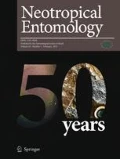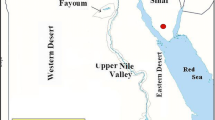Abstract
The male caste is firstly described for the ant genus Rhopalothrix. The male was collected as attached to the gyne during copula. Due to the rarity of the genus, the gyne and male are tentatively associated with R. apertor Longino and Boudinot 2013. The apomorphic features of Rhopalothrix male are discussed, and a preliminary identification key based on males to the genera in the Basiceros-genus group (formerly tribe Basicerotini) is provided.







Similar content being viewed by others
References
AntWeb (2021) AntWeb, California Academy of Sciences, San Francisco, California, USA. http://www.antweb.org. Accessed 1 October 2021
Baroni Urbani C, De Andrade ML (2007) The ant tribe Dacetini: limits and constituent genera, with descriptions of new species (Hymenoptera, Formicidae). Ann Museo Civico Storia Nat ‘Giacomo Doria’ 99: 1–191.
Bolton B (2003) Synopsis and classification of Formicidae. Mem Am Entomol 71:1–370
Boudinot BE (2015) Contributions to the knowledge of Formicidae (Hymenoptera, Aculeata): a new diagnosis of the family, the first global male-based key to subfamilies, and a treatment of early branching lineages. Eur J Taxonomy 120:1–62
Brown WL (1949) Revision of the ant tribe Dacetini: IV. Some genera properly excluded from the Dacetini, with the establishment of the Basicerotini, new tribe. Trans Am Entomol Soc 75:83–96
Brown WL Jr, Kempf WW (1960) A world revision of the ant tribe Basicerotini. Studia Entomologica 3:161–250
Cantone S (2017) Winged ants - the male. Dichotomous key to genera of winged male ants in the world. Behavioral ecology of mating flight. São Paulo
Deyrup M, Johnson C, Davis L (1997) Notes on the ant Eurhopalothrix floridana, with a description of the male (Hymenoptera: Formicidae). Entomol News 108:183–189
Dietz BH (2004) Uma revisão de Basicerotini Brown, 1949 (Formicidae: Myrmicinae), suas relações filogenéticas internas e com outras tribos dacetíneas (Dacetini e Phalacromyrmecini). Doctoral dissertation, Instituto de Biociências da Universidade de São Paulo (IB/USP), São Paulo, Brazil
Emery C (1922) Hymenoptera. Fam Formicidae Subfam Myrmicinae Genera Insectorum 174B:95–206
Kempf WW (1975) Miscellaneous studies on Neotropical ants VI. (Hymenoptera: Formicidae). Studia Entomologica 18:341–380
Longino JT, Boudinot BE (2013) New species of Central American Rhopalothrix Mayr, 1870 (Hymenoptera, Formicidae). Zootaxa 3616:301–324
Ogata K (1991) A generic synopsis of the poneroid complex of the family Formicidae (Hymenoptera). Part II. Subfamily Myrmicinae. Bulletin of the Institute of Tropical Agriculture Kyushu University 14:61–149
Probst RS, Wray BD, Moreau CS, Brandão CRF (2019) A phylogenetic analysis of the dirt ants, Basiceros (Formicidae: Myrmicinae): inferring life histories through morphological convergence. Insect Systematics and Diversity 3:1–12
Seifert B (2021) A taxonomic revision of the Palaearctic members of the Formica rufa group (Hymenoptera: Formicidae) - the famous mound-building red wood ants. Myrmecological News 31:133–179
Smith MR (1957) Revision of the genus Stenamma Westwood in America north of Mexico (Hymenoptera, Formicidae). Am Midl Nat 57:133–174
Ward PS, Brady SG, Fisher BL, Schultz TR (2015) The evolution of myrmicine ants: phylogeny and biogeography of a hyperdiverse ant clade (Hymenoptera: Formicidae). Syst Entomol 40:61–81
Acknowledgements
I thank Henri Goulet (CNC, Ottawa) for his help with the images and two anonymous reviewers who greatly improved the style and content of my manuscript.
Author information
Authors and Affiliations
Corresponding author
Ethics declarations
Conflict of interest
The author declares no competing interests.
Additional information
Edited by Takumasa Kondo
Publisher's Note
Springer Nature remains neutral with regard to jurisdictional claims in published maps and institutional affiliations.
Supplementary Information
Below is the link to the electronic supplementary material.
Rights and permissions
About this article
Cite this article
Borysenko, L.H. The Male of the Ant Genus Rhopalothrix (Hymenoptera: Formicidae: Myrmicinae). Neotrop Entomol 51, 413–422 (2022). https://doi.org/10.1007/s13744-022-00947-w
Received:
Accepted:
Published:
Issue Date:
DOI: https://doi.org/10.1007/s13744-022-00947-w




